The Art Detective
The L.A. Art Scene Was Booming. Why Are Galleries Suddenly Closing?
At least 10 galleries have shuttered since 2023—and more may soon.

At least 10 galleries have shuttered since 2023—and more may soon.

Katya Kazakina

Los Angeles has been a major source of optimism for the art world in recent years, with dealers flocking west like a new gold rush was underway.
Megas like David Zwirner and Hauser and Wirth have been making big bets on the city and enterprising smaller outfits have been opening, too. But some have been finding the situation on the ground to be trickier than they had hoped, especially when galleries are tightening their belts.
With alarming regularity, galleries all over Tinseltown have been closing, reducing their footprints, or decreasing their programming. “Hiatus” is a frequently heard word and there’s an expectation that more spaces are set to shutter soon.
Artist Amir Falah noted on Threads last month that several galleries had closed. He observed that these galleries were “pumping out shows and selling tons of work” during the pandemic buying boom. “They were getting a lot of attention at the time, but the writing was always on the wall,” he wrote. “Growing too fast, raising the prices of young artists too high, and only focusing on transactions and not long-term artistic growth for the artists they represent.”
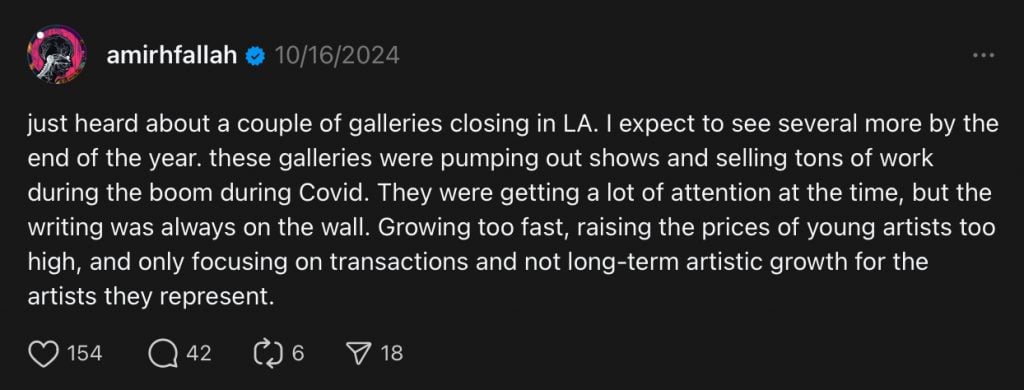
Photo: @amirhfallah/Threads
We shouldn’t really be surprised. The art market has been in retreat for two years. The same scenario is playing out in other art hubs, including New York and Hong Kong. Los Angeles, though, stands apart.
Because L.A. has a decentralized art scene, and because of the specific circumstances of some closures, it is hard to paint a definitive picture of what’s been happening. But my interviews with a dozen L.A. art dealers, who have closed or are thinking about it, reveal the specific challenges of this moment.
The State of Play
This week, I put together a list of 10 L.A. spaces that have closed in the past 18 months. In June 2023, New York’s Vito Schnabel left the old Santa Monica Post Office after staging six shows there, starting with a mini-retrospective of Francesco Clemente in late 2021. A gallery rep said that the space was always intended as “an experiment,” which ended when the gallery’s short-term lease expired.
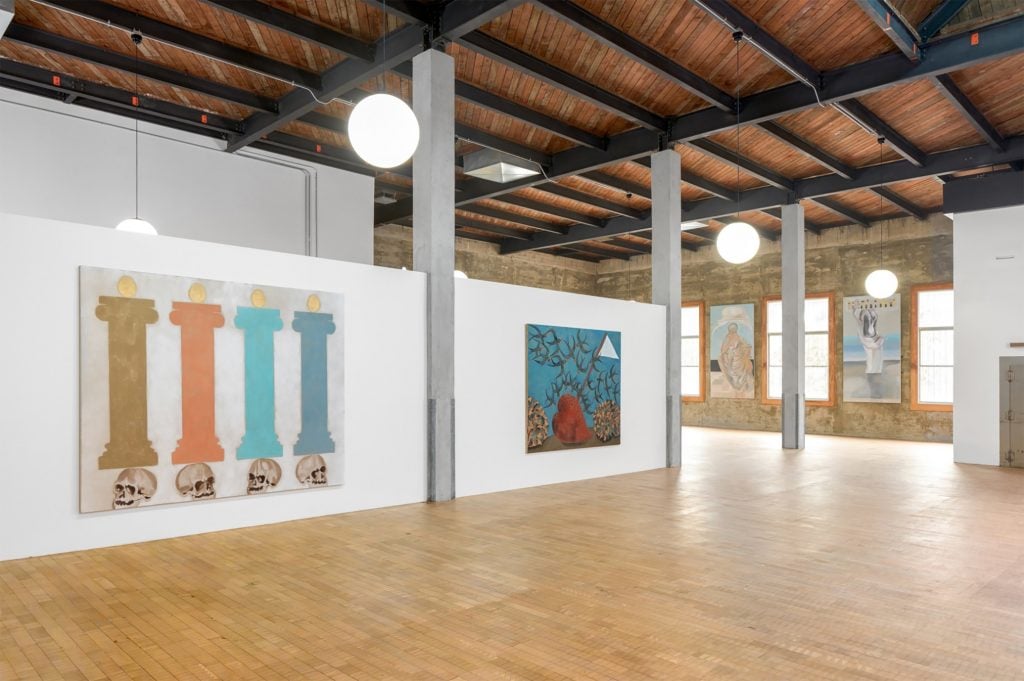
Francesco Clemente, Twenty Years of Painting: 2001 – 2021, Presented by Vito Schnabel Gallery and Alexander Dellal at the Old Santa Monica Post Office; Artworks © Francesco Clemente; Photo by Elon Schoenholz; Courtesy the Artist and Vito Schnabel Gallery
A few months later, Lorin Gallery, known for showing young emerging artists, closed its two spaces because clients stopped buying art, according to its owner, Dimitri Lorin.
Things intensified this May, when dealer Nino Mier abruptly shuttered his three spaces in Los Angeles amid allegations of nonpayments to artists, capping months of rumors about his troubles. (The gallery said it’s conducting an internal investigation and focusing on its operations in New York and Brussels.)
This summer, Carlye Packer, an emerging-art dynamo who put Lauren Halsey in a group show back in 2017, gave up her gallery space in Silver Lake and has been doing pop-up exhibitions. “I don’t want to litter an already littered landscape,” she said. “I work with artists and I sell artworks no matter if I am in my living room or in a physical location.”
Paris transplant Praz-Delavallade ended its final exhibition in L.A., where it had operated for seven years, in June. It closed its Paris operations a month later. In July, Smart Objects, an artist-run space known for spotting future stars like Lucy Bull, announced that it was going on a hiatus until 2025. (Emerging artist Ellen Hanson recently posted on Instagram about her painting exhibition there next February).
In September, the New York-based Harper’s, which went on an expansion spree during the pandemic, quietly closed its L.A. space. The same month, news broke that UTA Fine Arts, the United Talent Agency division, shuttered its art spaces in Los Angeles and Atlanta, following the departure of director Arthur Lewis.
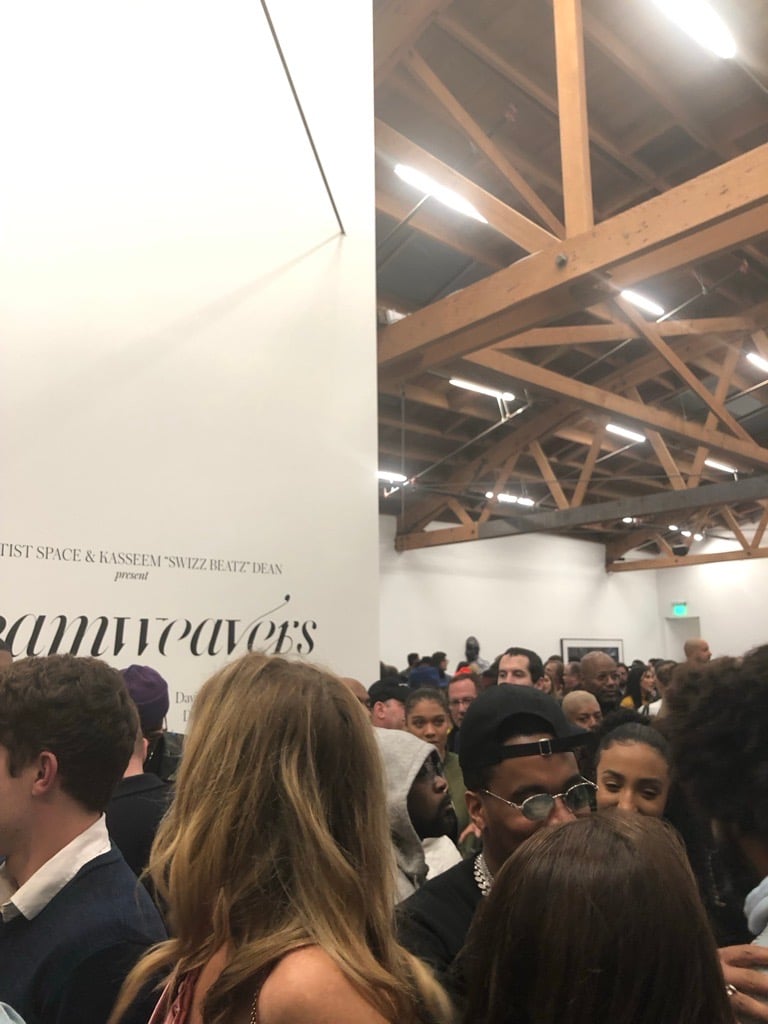
A mobbed opening at UTA Fine Arts in Los Angeles during Frieze LA in 2019. Photo: Katya Kazakina
Gavlak gallery, which is based in Palm Beach, Fla., and had been operating in L.A. for 10 years, just decided to depart Downtown L.A. “With our lease ending, we’re now shifting focus to New York City and Palm Beach—two vibrant hubs rich with our history, clients, artists, and museum connections,” owner Sarah Gavlak said.
Bill Powers, whose New York-based Half Gallery has been staging exhibitions at his Los Feliz residence since 2022, said he will suspend L.A. programming until next spring. “Part of the reset right now is refocusing and consolidation,” he said. “You want to be smart about resources.”
From Sold Out to Hold Out
Amid the slowdown in sales over the past two years, Los Angeles galleries have faced additional challenges. Namely, the pool of buyers there is smaller compared to New York. Demand from Asia has also significantly dropped, further reducing the volume of sales, dealers said. Sold-out shows, which had become the norm for some, are now the exception.
“Selling and buying art is no longer a rookie’s game and more of a venture for established collectors,” said Niels Kantor, a local dealer. “There aren’t sell-out shows, and maybe that should be normalized.”
Stefan Simchowitz, who closed his four spaces and consolidated everything on a private campus in Pasadena, said he estimates that top-tier galleries are seeing a 25-percent drop in revenue; on average, it’s a 35-to-40-percent decline, and the really weak players are down 50 to 70 percent.
“There are a lot of closures that are quiet, people moving into smaller spaces,” he said. “You are seeing a consolidation of square footage across town. You are just seeing a contraction. Business is bad.”
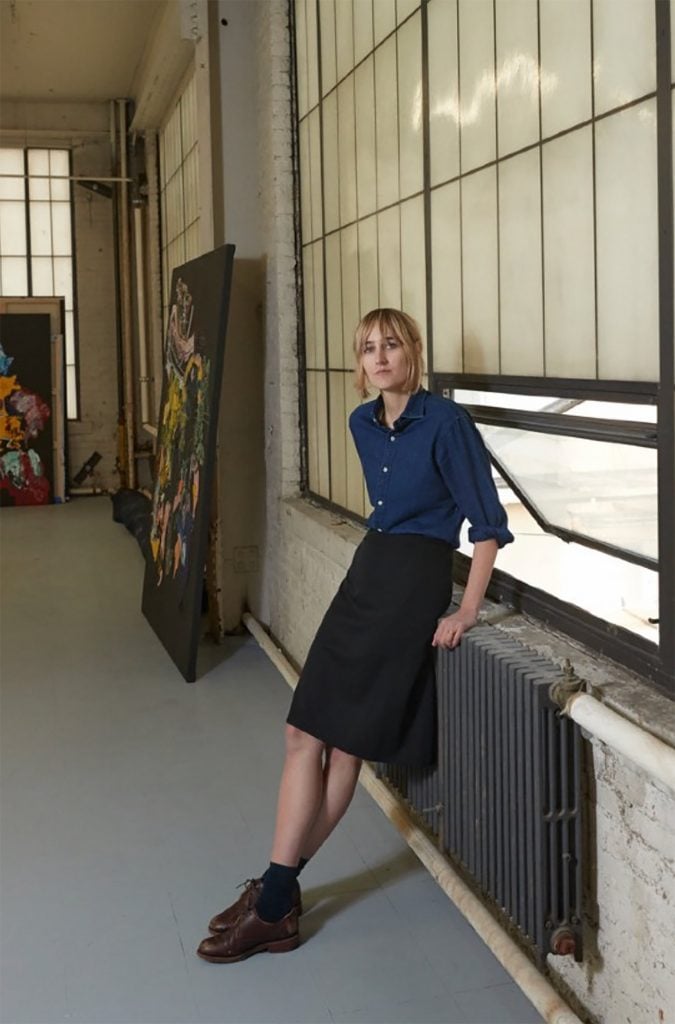
Leelee Kimmel’s show inaugurated the Journal Gallery Los Angeles earlier this year and was a success, with everything selling. Photo: The Journal Gallery
Lorin, who had come to Los Angeles from Hong Kong, represented young emerging artists with prices ranging from $10,000 to $20,000. Things were going well, with 90 percent of his exhibitions selling out, Lorin said this week from Portugal, where he now lives. But two years ago, things changed abruptly. Despite doing art fairs and cultivating clients around the world, including in Hong Kong, Singapore, and China, sales dried up.
“Everyone stopped buying at the same time,” he said, referring to new collectors who made money in crypto and NFTs, which both crashed at the time. “After months and months of zero sales, we decided to close both spaces. I lost so much money.”
Location, Location, Location
Geography has a lot to do with success in Los Angeles, according to Michael Nevin, whose Brooklyn-founded Journal gallery opened in March on the border of West Hollywood and Beverly Hills with a sold-out exhibition by Leelee Kimmel. The latest Hauser and Wirth emporium is across the street. Two doors down is Dan Tana’s, an institution of a restaurant known to attract stars of every stripe, from movies to music and sports.
“We have a built-in audience,” Nevin said, referring to collectors who live nearby. “Los Angeles is a tricky city to move around. If you are Downtown, forget it, you don’t even exist.”
Simchowitz, who spoke with me while visiting exhibitions mid-week, said he’s often alone in shows. “No one visits galleries in Los Angeles,” he said. “They feel dead. It’s like a morgue.”
Too Few Resources or Too Many Galleries?
While well-capitalized blue-chip galleries can dedicate substantial resources to staffing and programming their spaces even in tough times, smaller out-of-town galleries often feel overstretched.
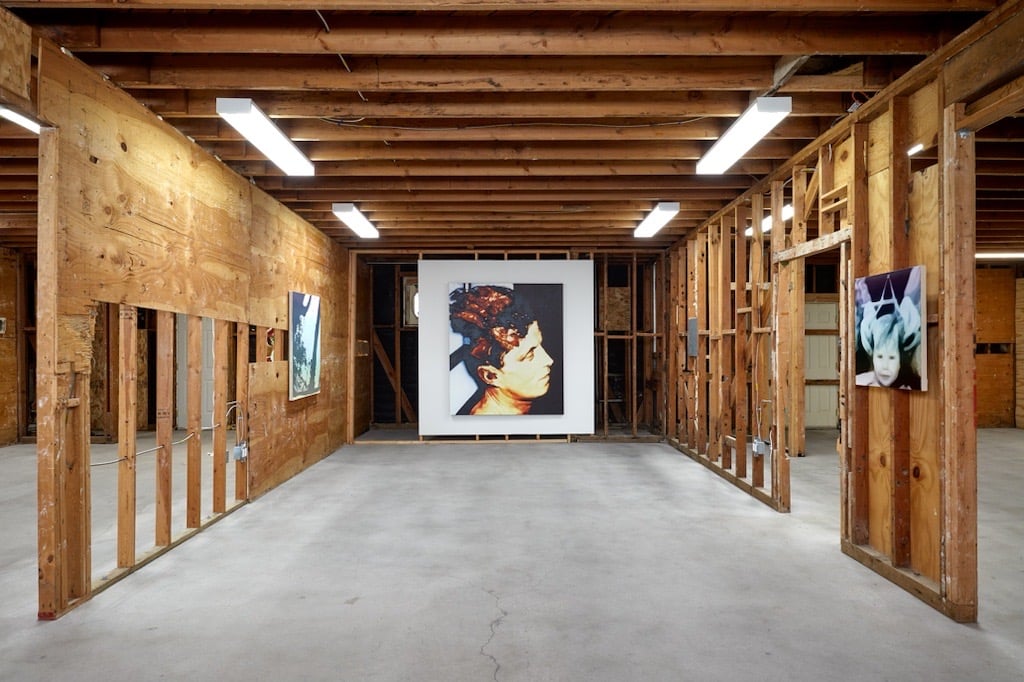
After closing her gallery in May, Carlye Packer recently presented Jacob Fenton’s paintings in a surprising temporary setting. Courtesy: Carlye Packer
New York gallerist Allegra LaViola has been shuttling back and forth between the coasts since opening a Los Angeles gallery in February 2023. It’s taken a toll. “It’s just a lot, personally and physically for me,” she said. “Having two spaces, having a young family, not having local L.A. roots and a big staff.”
At the same time, most of the sales that LaViola makes in L.A. aren’t to people living there, she said. She is now questioning the necessity of having a gallery in the city. “Nothing is off the table,” she said.
“L.A., even more than New York, has an anti-interloper stance,” said Powers, of Half Gallery. “Collectors and art fans of Los Angeles want you to be present rather than a ghost satellite.”
Bicoastal dealer Sebastian Gladstone, who has no plans to close in L.A., agreed. “Running a Los Angeles gallery like an outpost that’s getting diminished resources will inherently be difficult,” he said. “Building relationships with people takes time and you need to be on the ground to do this. Potentially, some of these galleries have overextended themselves with what their collectors are willing to acquire.”
Gladstone pushed back against the notion that Los Angeles is oversaturated with galleries. “From a cultural standpoint, definitely not,” he said. “Whether or not the collector base can sustain all the galleries here, it’s a different question.”